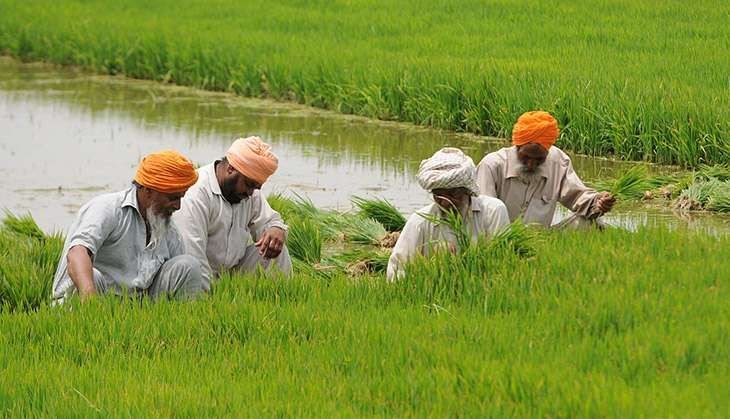
t’s pouring loan waivers. After the newly formed Congress governments in Madhya Pradesh and Chhattisgarh waived off farmer loans, the Ashok Gehlot-led Rajasthan government followed suit and waived off farmer loans of up to Rs 2 lakh taken till November 2018, fulfilling Congress chief Rahul Gandhi’s poll promise to write off loans within 10 days of coming to power.
The loan waiver would be applicable to short-term loans taken from cooperative banks and loans of up to Rs 2 lakh taken by farmers from nationalised, commercial or other banks till November 30. Chief Minister Ashok Gehlot tweeted that the loan waiver would cost the exchequer Rs 18,000 crore. Gandhi tweeted “It's done”.
On Monday, Madhya Pradesh Chief Minister Kamal Nath had cleared the proposal of waiving farm loans up to Rs 2 lakh, his first act as CM. The waiver is estimated to burden the state by Rs 35,000 to Rs 38,000 crore, benefiting around 34 lakh farmers in the state.
The same day, Chhattisgarh CM Bupesh Baghel, too, announced a waiver of short-term agriculture loans to the tune of over Rs 6,100 crore for more than 16.65 lakh farmers. These loans were drawn from cooperative banks and Chhattisgarh Gramin Banks.
Even the BJP decided to jump on the bandwagon, with the party-led Assam government approving Rs 600 crore farm loan waiver, which it said would benefit around 8 lakh farmers in the state. The waiver is structured as a 25 percent write-off on loans of each farmer, up to a maximum of Rs 25,000.
These cascading loan write-offs, while being populist measures meant to win favour and sentiment among the large voter base of farmers, are also a stress on state economy. In the three states that recently voted in Congress governments, the total cost of waivers is estimated to be between Rs 59,100 crore to Rs 62,100 crore.
CHHATTISGARH
The total targeted state expenditure of Chhattisgarh for 2018-19 is Rs 83,179 crore. The Gross State Domestic Product (GSDP) of the state for the fiscal year is estimated to be Rs 3,25,644 crore, a 11.7% increase from the revised estimates for 2017-18. The state estimates its outstanding liabilities in the year to be 18.06% of the GSDP, i.e. about Rs 58,811 crore.
This is known as the Debt to GSDP ratio. This ratio, expressed as a percentage, is a proportion of the state’s public debt to its gross domestic product (GDP). Or simply, the ratio of what a state owes to what it produces.
With the promised loan waivers, Chhattisgarh is about to incur an additional burden of Rs 6,100 crore, which will put a relatively small stress, an increase of 1.87 percentage points, over its estimated liabilities in the year.
But the loan waiver amount is more than twice the estimated amount Chhattisgarh had planned to spend on agriculture — Rs 2,366 crore — in the 2018-19 state budget. In the planned budget, the state, under the BJP government of Raman Singh, had allocated Rs 184 crore to provide interest-free short term agricultural loans.
Noticeably, the loan waiver amount — Rs 6,100 crore — is also almost twice the state’s allocation for education (Rs 3,180 crore) and public works (Rs 3,150 crore) sectors.
MADHYA PRADESH
Madhya Pradesh is a different story from Chhattisgarh. A bigger state has a bigger budget, but also bigger liabilities. The state budget target for 2018-19 is an estimated Rs 1,86,685 crore. The Gross State Domestic Product (GSDP) of Madhya Pradesh for 2018-19 is estimated to be Rs 8,26,106 crore, with outstanding liabilities forming 26.3 per cent of the GSDP, amounting to Rs 2,17,265 core.
After Chief Minister Kamal Nath’s loan waiver announcement, the state is going to incur an additional Rs 35,000 crore, at the least. This will cause an increase of 4.23 percent points in the debt to GSDP ratio of the state.
The loan waiver amount is also twice the amount allocated to education, four times the public works budget and equivalent to the entire rural development finances of the state in 2018-19.
The loan waiver figure also trounces the state’s agriculture budget, which was estimated at Rs 9,260 crore, that included Rs 3,650 crore for Mukhya Mantri Krishak Samriddhi Yojana, Rs 2,000 crore for the Prime Minister Crop Insurance Scheme and Rs 1,000 crore for the Mukhya Mantri Bhavantar Yojana.
The planned total agriculture expenditure for 2018-19 was already a whopping 87.4% more than what the state spent on the sector in 2017-18 (Rs 4,942 crore). Loan waivers are now set to pile additional stress on finances.
RAJASTHAN
The Vasundhara Raje-led BJP government in Rajasthan had already promised loan waivers of up to Rs 50,000 for farmers ahead of elections, which was costing the state Rs 8,000 crore.
The GSDP of Rajasthan for 2018-19 is estimated to be Rs 8,40,263 crore and the current state debt stands at Rs 2,77,287 crore or 33 percent of the GSDP.
Now, Ashok Gehlot government’s promise of loan waivers up to Rs 2 lakh is going to cost the state Rs 18,000 crore, where the total expenditure for the year is budgeted at Rs 2,12,000 crore. This will mean an increase of over 2 percentage points in the debt to GSDP ratio of the state.
The loan waiver amount in Rajasthan, a largely rural state, is almost three times the planned outlay — Rs 6744.84 — for agriculture budgeted under Raje government. It also exceeds the state education, transport, irrigation and rural development budgets.


.jpeg)

